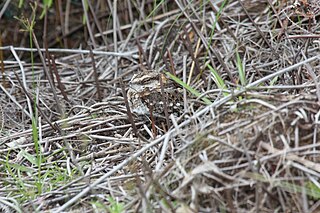
The lesser swallow-tailed swift or Cayenne swift is a species of bird in subfamily Apodinae of the swift family Apodidae. It is found from southern Mexico through Central America; in every mainland South America country except Argentina, Chile, Paraguay, and Uruguay; and on Trinidad.

The pale-vented pigeon is a large pigeon found in the tropical Americas. Formerly often placed in Columba, it actually belongs to a clade of the older New World genus Patagioenas. With its relatives it represents an evolutionary radiation extending through most of the warm-temperate to tropical Americas. Grey-hued birds, even their males generally lack iridescent display plumage, although the present species has some coppery gloss on the nape.

The green ibis, also known as the Cayenne ibis, is a wading bird in the ibis family Threskiornithidae. It is the only member of the genus Mesembrinibis.

The white-tailed nightjar is a species of nightjar in the family Caprimulgidae. It is found in the tropic regions of Central and South America.
Acontista cayennensis is a species of mantid in the family Acontistidae.
Eriochrysis is a genus of African and Neotropical plants in the grass family.
Stigmaulax cayennensis is a species of predatory sea snail, a marine gastropod mollusk in the family Naticidae, the moon snails.

Stachytarpheta cayennensis is a species of flowering plant in the verbena family known by many English language common names, including blue snakeweed, Cayenne snakeweed, dark-blue snakeweed, bluetop, nettle-leaf porterweed, rattail, rough-leaf false vervain, blue rat's tail, Brazilian tea, Cayenne vervain, false verbena, joee, nettleleaf velvetberry, and Cayenne porterweed. Names in other languages include honagasō (Japanese), gervão-urticante, piche de gato, rabo de zorro (Spanish), herbe á chenille, herbe bleue, queue de rat (French), ōi or ōwī (Hawaiian), sakura or ouchung (Chuukese), and tiāki (Māori). It is native to the Americas, from Mexico south through Central and South America to Argentina, as well as many islands of the Caribbean. It is known in many other parts of the world as an introduced species, including regions in Africa, India, Indonesia, Australia, Florida in the United States, and many Pacific Islands. Its distribution is now considered pantropical. In many places, such as New Caledonia, it has become an invasive species.

Taeniotes is a genus of flat-faced longhorns beetles in the subfamily Lamiinae of the family Cerambycidae.
Taeniotes subocellatus is a species of flat-faced longhorn beetles in the subfamily Lamiinae of the family Cerambycidae.
Taeniotes dentatus is a species of beetle in the family Cerambycidae. It was described by Dillon and Dillon in 1941. It is known from Ecuador and Colombia.
Taeniotes iridescens is a species of beetle in the family Cerambycidae. It was described by Dillon and Dillon in 1941. It is known from Costa Rica, Colombia, Brazil, and Panama.
Taeniotes batesi is a species of beetle in the family Cerambycidae. It was described by James Thomson in 1879. It is known from Colombia.
Taeniotes leucogrammus is a species of beetle in the family Cerambycidae. It was described by James Thomson in 1865.

Taeniotes luciani is a species of beetle in the family Cerambycidae. It was described by James Thomson in 1859. It is known from Colombia, Mexico, Honduras, Belize, Guatemala, Costa Rica and Panama.
Taeniotes marmoratus is a species of beetle in the family Cerambycidae. It was described by James Thomson in 1865. It is known from Ecuador.
Taeniotes affinis is a species of beetle in the family Cerambycidae. It was described by Stephan von Breuning in 1935. It is known from Peru and Ecuador.
Taeniotes parafarinosus is a species of beetle in the family Cerambycidae. It was described by Olivier in 1790. It is known from Peru, Brazil, Costa Rica, Panama, French Guiana, Bolivia, Guyana, and Suriname. It has also been introduced into Guadeloupe.

Taeniotes naevius is a species of beetle in the family Cerambycidae. It was described by Henry Walter Bates in 1872. It is known from Ecuador, Colombia, and Peru.

Taeniotes farinosus is a species of beetle in the family Cerambycidae. It was described by Carl Linnaeus in 1758, originally under the genus Cerambyx.








